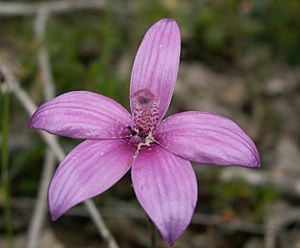Pink enamel orchid facts for kids
Quick facts for kids Pink enamel orchid |
|
|---|---|
 |
|
| Caladenia emarginata growing near Kirup | |
| Scientific classification | |
| Genus: |
Caladenia
|
| Species: |
emarginata
|
| Synonyms | |
|
|
The pink enamel orchid (Caladenia emarginata) is a beautiful plant that belongs to the Orchid family. You can only find this special orchid in the south-west part of Western Australia. It's a ground orchid, meaning it grows in the soil. It has a single flat, hairy leaf and can grow up to four shiny pink flowers. This orchid looks a bit like another one called Caladenia brunonis, but the pink enamel orchid is usually shorter and has bigger, pinker flowers.
Contents
What the Pink Enamel Orchid Looks Like
The pink enamel orchid is a plant that grows from the ground. It's a perennial plant, which means it lives for more than two years. It also loses its leaves during certain seasons, like a deciduous tree. This orchid has a special underground tuber (like a small potato) that helps it store food. Sometimes, many of these orchids grow together in groups.
It has one flat, dark green, hairy leaf that is about 20–80 mm (0.8–3 in) long and 7 mm (0.3 in) wide. The base of the leaf is reddish.
Its Flowers
The pink enamel orchid can have up to four glossy pink flowers. Each flower is about 30–50 mm (1–2 in) long and wide. These flowers grow on a stem (called a spike) that stands 120–250 mm (5–10 in) tall.
The parts of the flower that look like petals are called sepals and petals. They spread out and have red or purple blotches on their backs.
- The top sepal (called the dorsal sepal) stands straight up. It is about 16–23 mm (0.6–0.9 in) long and 6–8 mm (0.2–0.3 in) wide.
- The side sepals are similar in size to the top one.
- The petals are about 14–20 mm (0.6–0.8 in) long and 6–8 mm (0.2–0.3 in) wide.
The labellum is a special lip-like petal. It is thin, about 4–5 mm (0.16–0.20 in) long and 1.5 mm (0.06 in) wide. It is whitish and its tip twists into an S-shape. At the bottom of the labellum, there are two dark purple, club-shaped bumps called calli. They are about 5–7 mm (0.2–0.3 in) long.
This orchid usually blooms from October to December.
How it Got its Name
Taxonomy and Naming History
The pink enamel orchid was first officially described in 1839 by a scientist named John Lindley. He called it Glossodia emarginata. Later, in 1871, Heinrich Gustav Reichenbach changed its name to Caladenia emarginata. Then, in 1963, Alex George changed it again to Elythranthera emarginata.
However, in 2015, after new studies using molecular phylogenetics (which looks at the plant's DNA), Mark Alwin Clements changed the name back to Caladenia emarginata. This is the name that is accepted by the Royal Botanic Gardens, Kew today.
The second part of its name, emarginata, comes from a Latin word that means "notched at the apex" or "with a small notch at the tip." This refers to the two calli (bumps) on its labellum.
Where it Lives
Distribution and Habitat
You can find the pink enamel orchid in many places across Western Australia. It grows as far north as Jurien Bay and as far east as Ravensthorpe. It often grows in groups or clumps in wet areas like swamps, near creeks, and in thick heathland.
Conservation Status
The Western Australian Government's Department of Parks and Wildlife says that Caladenia emarginata is "not threatened." This means there are enough of these orchids, and they are not currently in danger of disappearing.

